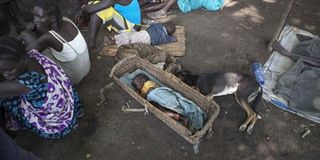South Sudan conflict earns Ethiopia a rare accolade

A young girl displaced by fighting in South Sudan sleeps while her family waits to be registered in the Kule 1 and 2 camps for Internally Displaced People at the Pagak border crossing in Gambella, Ethiopia, on July 10, 2014. FILE PHOTO | ZACHARIAS ABUBEKER
What you need to know:
- Chad takes the third place in the list of African nations hosting refugees.
- It isn’t surprising, at least to the UNHCR that the number of refugees in the region has gone up.
The UN refugee’s agency last week gave Ethiopia an accolade.
The United Nations High Commissioner for Refugees said the country had overtaken neighbouring Kenya as the largest refugees host in Africa.
The total number was 630,000 by the end of July. Those are just the registered ones, mark you.
Most of them, nearly 190,000, are South Sudanese. They’ve flocked to the country since violence erupted in their homeland mid-December.
Ethiopia, the agency said, is also hosting 245,000 Somalis and nearly 100,000 Eritreans. Kenya is hosting 575,000 refugees, mostly Somalis.
Chad takes the third place in the list of African nations hosting refugees with 348,528 from Sudan’s West Darfur region and the Central Africa Republic.
It would have been interesting had the agency given the number of Ethiopian refugees, for example, in Kenya, Yemen and, surprisingly, Eritrea.
Spokesman Adrian Edwards said there were 23 camps and five transit sites.
Three of the camps established early this year have reached the limit. Therefore, two new ones are being established. After all, there are 25,000 new arrivals each month.
Hopefully, South Sudan President Salva Kiir and his former vice president turned rival Riek Machar, who shook hands on agreeing to a cease-fire that never was, in Ethiopians capital, Addis Ababa, early this year, noted how infamously their quarrel contributed to Ethiopia’s accolade.
It isn’t surprising, at least to the UNHCR that the number of refugees in the region has gone up.
Its 2014 regional operations profile began as follows: The East and Horn of Africa region continues to suffer from conflict and displacements.
THE TWO SUDANS
Incidentally, the East and Horn of Africa for the UNHCR, geographically includes eastern Democratic Republic of Congo, the two Sudans and Eritrea.
Contrary to popular opinion, the UNHCR’s concerns aren’t limited to caring for people who, with only clothes on their back and meagre belongings, flee their homelands.
The concerns and provision of services and protection include persons in the following categories: asylum-seekers, returnees, including those who end up displaced, stateless people, internally displaced without ever having left their homeland and a category the agency describes simply as “others.”
In the East and Horn of Africa region, the profile put the category of the population of concern at 6 million people. Included are 1.8 million refugees and more than 3 million internally displaced. The cost of catering for them is a tidy US$1.17 billion.
Notable is that the UNHCR profile of operations in the continent also begins with an observation: “Conflict, violence and human rights abuses continue…” In fact, other than figures, such ominous predictions preface profiles of every region in the continent.
Of course the UNHCR isn’t in the business of delving into ways of addressing the issues that produce the categories of needy people. It would follow, therefore, that leaders in countries that produce the needy and those who received them should develop ways to dialogue.
This, of course, is tricky. It amount to an equivalent of neighbours telling each other “Look, you are causing us problems. Sort out things at home.”
Done respectfully though, it can work, hopefully lead to better governance and usher in an era of accolades for the countries that export fewer refugee.




